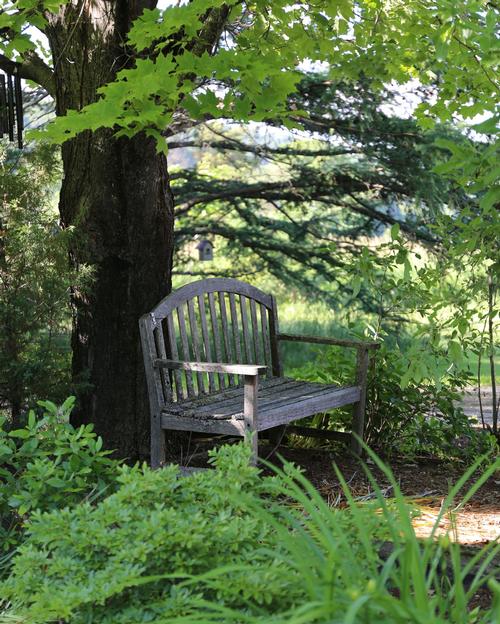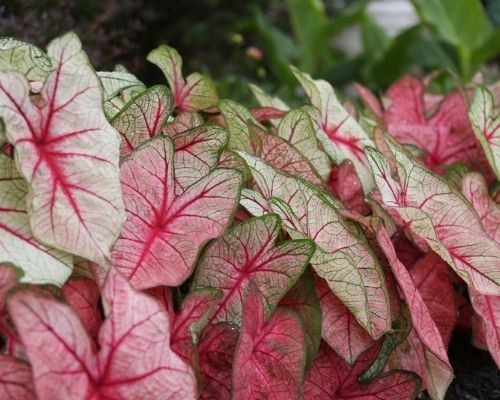How to Make a Shady Garden Shine
Garden designers use the same basic principles of design whether they're designing for sun or shade. But they also know that our eyes see differently when there is less light and this creates some unique design opportunities.
Next time you’re outdoors, try this little experiment. Walk around for a while in a sunny part of your yard and then step into the shade. As your eyes adjust to the change in light, you’ll be surprised by how much more detail you can see. You’ll start looking more carefully and moving around more slowly to take it all in. These shifts in perception and mood are what give shade gardens their special magic.
Here are seven tips that can help you make the most of a shady site.
Using Color in Shady Areas
Flowers are usually the main attraction in a sunny garden, but they become less important in a shade garden. In shade, foliage plays a much bigger role and a garden designer’s challenge is to artfully combine leaf shapes, sizes, textures and colors.
When you stand in the shade, you’ll notice that deep reds and dark purples recede into the shadows, while white, yellow, pink and lavender shine out and attract your eyes. The darks look darker and the brights seem brighter.
To create visual excitement, contrast darks with lights. The lemon-lime foliage of dicentra ‘Spring Gold’ or Heuchera 'Lime Marmalade' really pop when they're planted beside dark leaved heuchera or cimicifuga. You can get a similar effect by pairing two hostas, such as blue-grey ‘Bressingham Blue’ with the creamy white bi-color ‘Blue Ivory’. Plants with variegated foliage are particularly effective in the shade because every leaf displays this dark-light contrast.
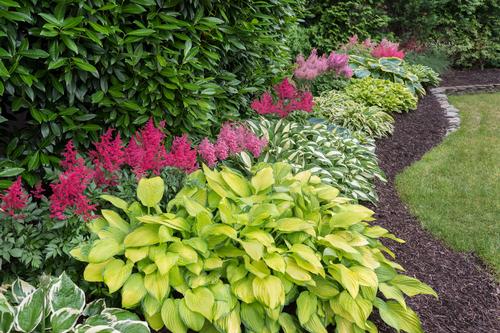
Of course flowers are another way to add color to shady areas. Plants with colorful blossoms include tuberous begonias, dicentras, primroses, astilbes, foxgloves and hellebores. Contrasting colors -- whether it's flowers or foliage -- grab our attention. Yet it's also important to repeat colors. Repetition is soothing on the eyes and establishes a visual rhythm that pulls us through the garden. Your design will be more pleasing if you can strike a balance between contrast and repetition.
Making the Most of Texture
In shady gardens we are attracted to richly textured surfaces, such as the velvety leaves of lady’s mantle or the smooth, glossy leaves of lily of the valley. So it’s important to consider leaf texture as well as color.
The entire plant also conveys an overall texture. Most hostas, for instance, have a bold, coarse texture, while ferns and dicentra have a fine, lacy texture. Look for opportunities to emphasize these textural contrasts.
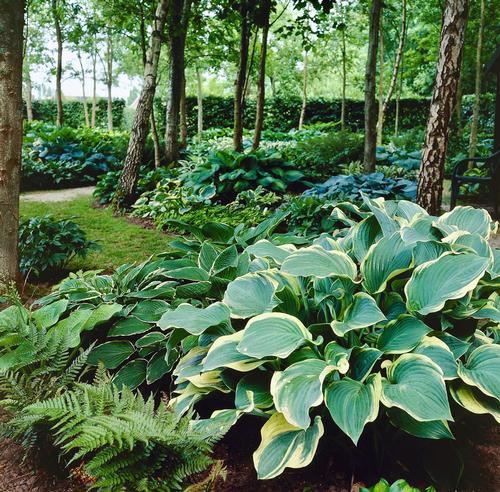
Creating Interesting Shapes
Garden designers also use plant shapes to guide our eyes through space. Pyramidal and columnar forms serve as exclamation points. Rounded, weeping, or spreading forms are grounding and help create a sense of flow.
If you place several plants of the same variety next to each other, your eyes will read them as a single shape. Many plants can be grouped together to create large irregular shapes. Strive for a combination of single plants, clumps and groups. Repeating these patterns will help unify a garden and give it a sense of movement.
A Different Approach to Paths and Edges
Neatly edged borders and closely cropped lawns are the hallmarks of a well-maintained garden. But shady gardens often seem to call for a more casual approach. Plants are allowed to spill over edges; turf is replaced by mulch or ground covers. The overall effect is softer and more natural.
Pathways may also be more informal. Multiple routes can invite meandering. Stepping-stones can be used to slow the pace and encourage exploration. Underfoot, bark mulch, shredded leaves or groundcovers give pathways a softer, quieter feel.
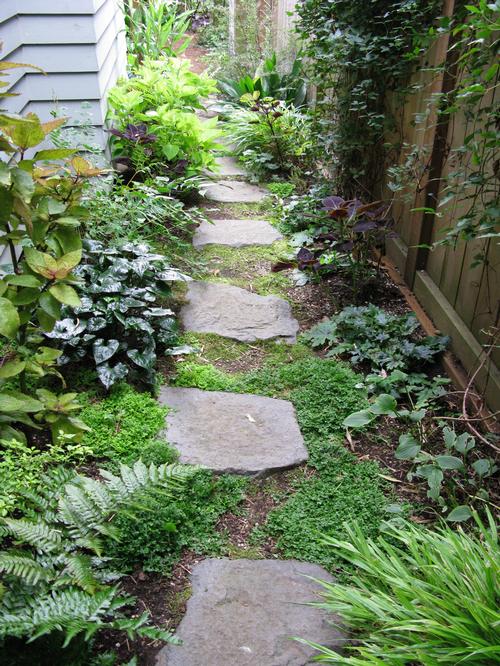
Adding Spring Bulbs and Other Bursts of Color
A garden that emphasizes foliage rather than flowers will maintain its good looks from spring into fall. Flowers become colorful accessories that change through the seasons.
Spring bulbs such as snowdrops, chionodoxa, scilla, fritillaria, and daffodils are ideal for shady gardens because they will naturalize and return to bloom again every year. Tulips perform beautifully in shady gardens, as do spring-flowering perennials such as hellebores, primroses, trillium and Solomon’s seal.
For summer color, include begonias, astilbes, dicentra and heucheras. Tropical bulbs such as caladiums will dazzle from summer through fall.
Shrubs and small trees can also add seasonal color. Shade tolerant choices with showy flowers include serviceberry, redbud, rhododendron and mountain laurel.
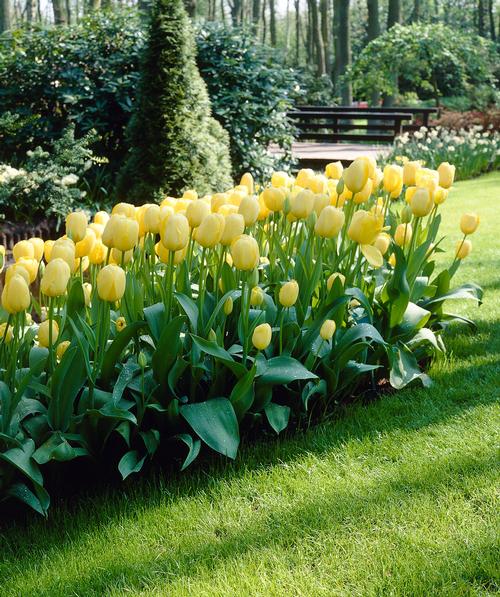
The Eternal Appeal of Water
Moving water can make shady gardens come alive. A splashing fountain or gurgling stream becomes a soothing soundtrack and the flashes of light provide endless entertainment.
Still water is effective, too. A beautiful ceramic pot or a simple water-filled dish or puddle stone act as mirrors to reflect sunlight as it filters through the trees above. Including water in your shade garden will also attract wildlife, from butterflies and dragonflies to birds, toads and small mammals.
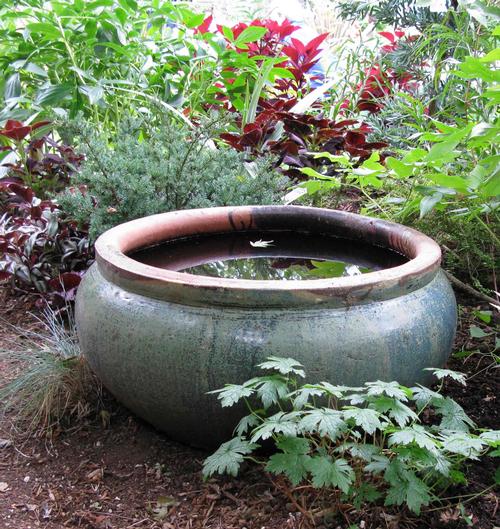
Seating Encourages Rest and Reflection
To emphasize the soothing nature of a shade garden, include a place to sit. Even if it’s not used very often, a bench or chair is an invitation to relax and take a break. Garden benches also create focal points and can be the inspiration for a special destination within the overall design. Natural materials, like weathered wood or stone, harmonize most effectively with a shady garden.
To shop our selection of spring-planted bulbs and perennials that thrive in the shade, click HERE. To learn more about gardening in the shade, read Choosing Plants for Sun or Shade. You may also be interested in reading:
Easy Summer Bulbs for Shady Containers
Summer Bulbs for Shady Gardens
Spring-Blooming Bulbs for Shady Gardens.
